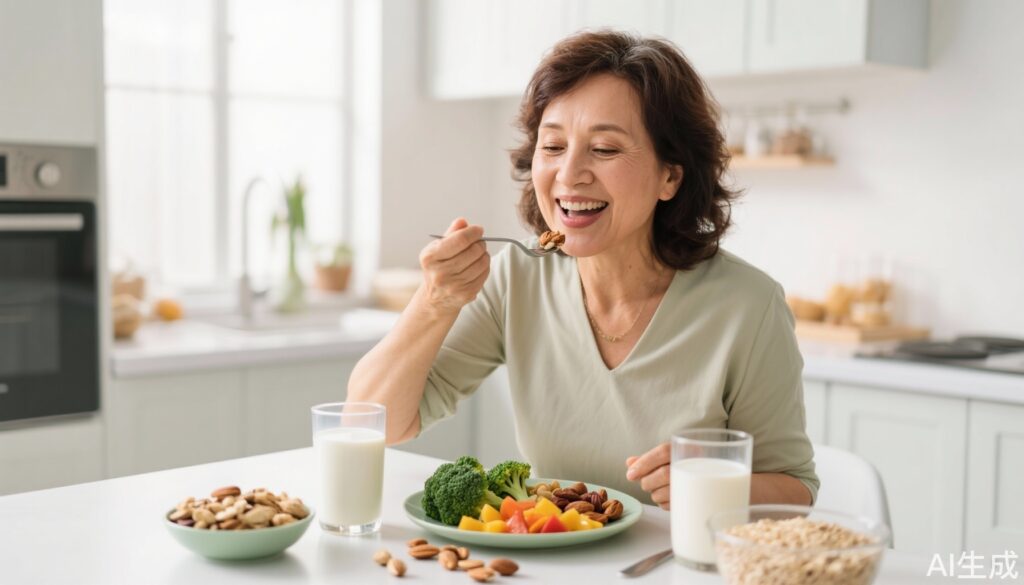Introduction
Women over the age of 40 often experience noticeable changes in their physical and emotional well-being—fatigue, disrupted sleep, changes in skin texture and tone, and irregular menstrual cycles. These symptoms commonly relate to fluctuations in hormone levels, particularly a decline in progesterone, a pivotal hormone for women’s health. Understanding the role of progesterone and how diet can support its levels is vital for women seeking to age gracefully and maintain vitality.
Understanding Progesterone and Its Importance
Progesterone is a key steroid hormone primarily produced by the ovaries. It partners with estrogen to regulate the menstrual cycle, prepare the uterus for pregnancy, protect the uterine lining, and influence metabolic processes. After age 40, ovarian function naturally declines, leading to reduced progesterone production. This hormonal shift can manifest as sleep disturbances, mood swings including anxiety and depression, increased abdominal fat, and skin changes such as dryness and loss of elasticity.
Beyond its reproductive roles, progesterone modulates the nervous system and has a calming effect that helps maintain emotional equilibrium. It also contributes to bone health and cardiovascular function, underscoring its systemic importance.
Why Dietary Sources Matter: Plant-Based Progesterone Support
Hormone replacement therapy is available but not suitable for everyone due to potential risks and side effects. Nutrition offers a safe and accessible approach to support hormone balance. Certain foods contain phytoestrogens and compounds that act as precursors or modulators of progesterone and estrogen activity in the body, often referred to as plant-based progesterone or phytoprogestogens.
Incorporating these foods not only helps modulate hormone levels but also provides additional nutrients essential for overall health.
Top 4 Foods That Naturally Support Progesterone Levels
1. Soy Milk and Soy Products
Soy is rich in isoflavones, a class of phytoestrogens structurally similar to human estrogen, capable of exerting dual regulation on hormone receptors. When estrogen levels are low, isoflavones can mildly stimulate estrogenic activity; conversely, when levels are high, they can inhibit excess stimulation, helping to restore balance.
Recommended Recipe: Golden Soy Milk
– Ingredients: 50 g soybeans, 30 g millet, 15 g pumpkin seeds, 5 red dates.
– Preparation: Soak soybeans for 8 hours. Rinse all ingredients and place into a soy milk maker with water to the indicated level. Select the ‘multigrain soy milk’ setting. Optionally garnish with goji berries after preparation.
Consuming soy milk 3–5 times per week, providing approximately 30–50 mg of isoflavones daily, has been shown to alleviate menopausal symptoms and support bone health.
2. Nuts and Seeds
Nuts like walnuts and almonds, along with seeds such as pumpkin and flaxseed, are rich in vitamin E, zinc, selenium, and lignans—plant compounds that act as weak phytoestrogens enhancing hormonal balance. These micronutrients are vital cofactors in the synthesis and regulation of hormones.
Recommended Recipe: Radiance Nut Energy Bars
– Ingredients: 50 g walnut halves, 50 g almonds, 30 g pumpkin seeds, 20 g ground flaxseed, 100 g oats, honey as needed.
– Preparation: Lightly toast the nuts at 180°C for 5 minutes. Combine all dry ingredients, mix in honey until the mixture can be formed into a firm dough. Press into a baking tray and bake at 170°C for 15–20 minutes. Allow to cool before cutting into bars.
A daily serving of 20–30 g of nuts and seeds can support hormone synthesis without excessive calorie intake.
3. Broccoli and Other Dark Green Vegetables
Broccoli, kale, and similar vegetables contain vitamin C, vitamin K, folate, and some plant estrogens. Their antioxidant properties help protect ovarian tissue from oxidative damage, indirectly facilitating progesterone production.
Recommended Recipe: Broccoli Sesame Tofu Salad
– Ingredients: 200 g broccoli, 150 g firm tofu, 15 g white sesame seeds, soy sauce and vinegar to taste.
– Preparation: Blanch broccoli florets for 2 minutes. Mash tofu and crush sesame seeds. Combine all and toss with seasonings. Chill before serving for enhanced flavor.
Light cooking methods like steaming or quick sautéing preserve nutritional quality.
4. Whole Grains
Brown rice, oats, and quinoa provide B-complex vitamins and dietary fiber, crucial for hormone metabolism and excretion. Fiber helps eliminate excess estrogens, promoting hormonal balance.
Recommended Recipe: Three-Grain Health Porridge
– Ingredients: 50 g black rice, 30 g oats, 20 g quinoa, 10 g goji berries, 10 g dried longan.
– Preparation: Soak black rice for 2 hours. Rinse all grains and cook with an appropriate amount of water. Simmer for 40 minutes after boiling, then add goji berries and longan, cooking for an additional 10 minutes. Sweeten naturally as desired.
Gradually increasing fiber intake allows the digestive system to adapt comfortably.
Integrating Dietary and Lifestyle Strategies
While these foods contain beneficial compounds supporting progesterone and hormonal balance, no single food works in isolation. A balanced diet incorporating these staples, limiting refined sugars, processed foods, and excess carbohydrates, paired with regular exercise, stress management, and adequate sleep, optimizes hormonal health.
Patience is essential—consistent dietary changes over 3 to 6 months are generally needed to notice improvements in sleep quality, mood stabilization, and skin vitality.
Case Vignette: Emily’s Journey to Hormonal Balance
Emily, a 45-year-old woman, reported increased fatigue, irregular periods, and dry skin. Her physician noted signs consistent with perimenopause and suggested lifestyle and dietary adjustments over immediate hormone therapy.
Emily incorporated soy milk several times weekly, added nuts and seeds as snacks, increased her intake of steamed broccoli and other greens, and replaced refined grains with whole grains like quinoa and oats. After four months, Emily experienced better sleep, reduced mood swings, and her skin regained a healthier glow, illustrating the effectiveness of dietary hormone support.
Expert Insights
Endocrinologists emphasize the importance of individualized approaches to hormone balance. Dr. Lisa Martin, a reproductive endocrinologist, notes, “While plant-based phytohormones are not identical to human hormones, they can provide a gentle nudge toward balance, especially when combined with lifestyle modifications.”
Conclusion
Progesterone plays an integral role in women’s health, influencing reproductive, emotional, and metabolic functions. As natural production declines with age, especially beyond 40, dietary strategies utilizing foods rich in plant-based progestogenic compounds offer a safe, accessible approach to support hormone balance. Integrating soy products, nuts, dark leafy vegetables, and whole grains can enhance vitality, mood, skin health, and overall well-being. Consistency and a holistic lifestyle are key to unlocking these benefits.
References
1. Setchell KD, Cassidy A. Dietary Isoflavones: Biological Effects and Relevance to Human Health. J Nutr. 1999;129(3):758S-767S.
2. Messina M. Insights gained from 20 years of soy research. J Nutr. 2010;140(12):2289S-2295S.
3. Lobo RA. The role of progesterone in hormone therapy: New insights and controversies. Climacteric. 2017;20(3):231-237.
4. Winters SJ. Hormone Replacement Therapy and Its Effects on Metabolic and Cardiovascular Health. Endocrinol Metab Clin North Am. 2018;47(1):97-112.
5. Fugh-Berman A. Herb-drug interactions. Lancet. 2000;355(9198):134-138.
6. North American Menopause Society. The 2017 hormone therapy position statement of the North American Menopause Society. Menopause. 2017;24(7):728-753.



